| Article ID | Journal | Published Year | Pages | File Type |
|---|---|---|---|---|
| 1185582 | Food Chemistry | 2015 | 8 Pages |
•Highlighted significant differences in the mineral composition by the honey type.•High correlations were found between the main pollen types and the minerals of honey.•MPLS models indicated that it is possible to predict pollen and minerals using NIRS.•NIRS combined with multivariate analysis contributed to the prediction of honey origin.
Consumers demand to know the floral origins of honeys. Therefore, the use of simple and reliable techniques for differentiating among honeys by their origins is necessary. Multivariate statistical techniques and near infrared spectroscopy applied to palynological and mineral characteristics make it possible to differentiate among the types of honey collected from Northwestern Spain. Prediction models using a modified partial least squares regression for the main pollen types (Castanea, Eucalyptus, Rubus and Erica) in honeys and their mineral composition (potassium, calcium, magnesium and phosphorus) were established. Good multiple correlation coefficients (higher than 0.700) and acceptable standard errors of cross-validation were obtained. The ratio performance deviation exhibited a good prediction capacity for Rubus pollen and for Castanea pollen, whereas for minerals, for Eucalyptus pollen and for Erica pollen the ratio performance deviation was excellent. Near infrared spectroscopy was established as a rapid and effective tool to obtain equations of prediction that contribute to the honey typification.
